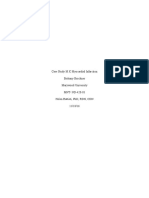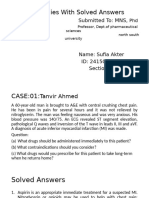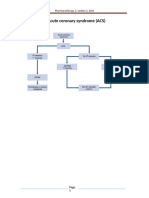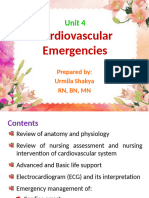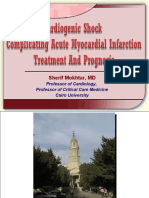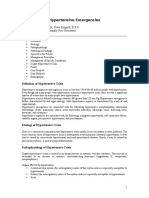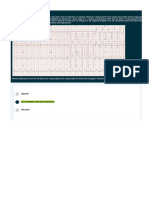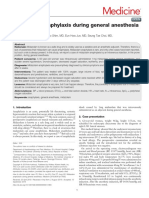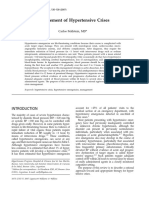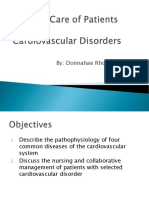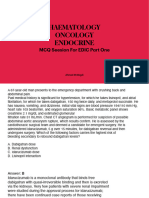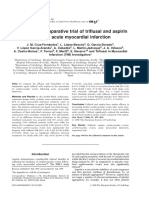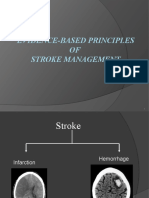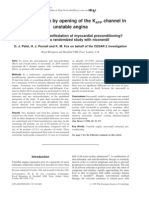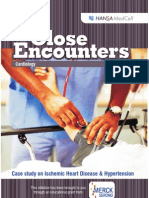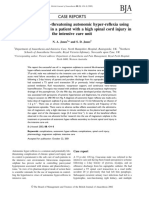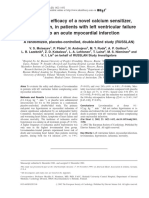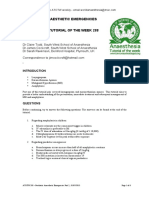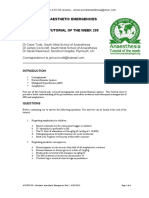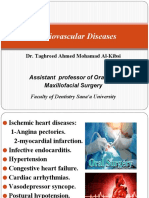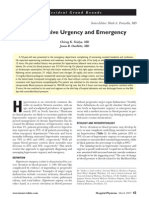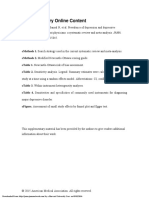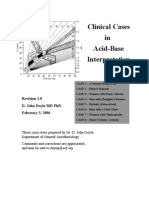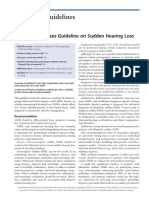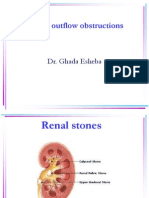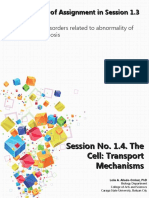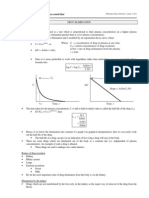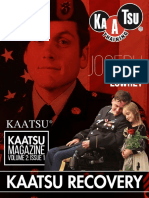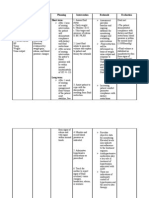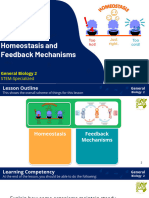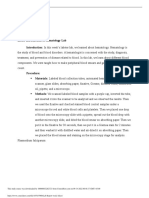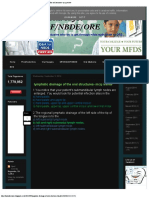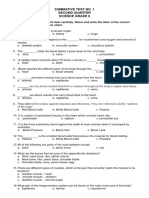Emergency Management of Acute Myocardial Infarction: Simon Maxwell
Emergency Management of Acute Myocardial Infarction: Simon Maxwell
Uploaded by
Maram AbdullahCopyright:
Available Formats
Emergency Management of Acute Myocardial Infarction: Simon Maxwell
Emergency Management of Acute Myocardial Infarction: Simon Maxwell
Uploaded by
Maram AbdullahOriginal Title
Copyright
Available Formats
Share this document
Did you find this document useful?
Is this content inappropriate?
Copyright:
Available Formats
Emergency Management of Acute Myocardial Infarction: Simon Maxwell
Emergency Management of Acute Myocardial Infarction: Simon Maxwell
Uploaded by
Maram AbdullahCopyright:
Available Formats
Emergency management of acute myocardial infarction
Simon Maxwell
Clinical Pharmacology Unit, The University of Edinburgh, Western General Hospital, Edinburgh EH4 2LH
Introduction
Ischaemic heart disease remains the commonest cause of death in the UK. Among its various manifestations, acute myocardial infarction continues to present a particular challenge to emergency health services. This case will be used to illustrate some of the therapeutic advances that have been made in the management of myocardial infarction over recent years and will highlight some of the areas that remain controversial. The review will concentrate on the immediate and early management priorities that arise within the rst day of admission to hospital (Table 1).
Case presentation
A 57 year old man presented to the Accident and Emergency Unit of his local district general hospital complaining of 2 h of central crushing chest pain radiating to the neck and shoulders. This had begun shortly after dinner and was more severe than any pain he had previously experienced. His wife explained that for the last 4 months he had been having episodes of indigestion at work which were only partially relieved by self-administered antacid preparations. They had rst rung their General Practitioner but he had advised them to call for an ambulance urgently. The past medical history included a diagnosis of hypertension 8 years earlier and a hernia repair 3 years earlier. He was also diagnosed as having a duodenal ulcer at endoscopy 2 years earlier but this had responded well to a course of cimetidine. At the time of admission his only relevant drug history was nifedipine 20 mg twice daily. The family history included the sudden death of his father aged 55 years (cause unknown). It was also known that his mother was hypertensive, his elder brother had angina and that his paternal grandmother had type 2 diabetes mellitus. He was married with two sons and worked as a bus driver. He was a regular smoker (20 per day) and consumed approximately 16 units of alcohol per week. On examination he looked grey and unwell, and was sweating. There was an early lower segment corneal arcus. The blood pressure was 138/94 mmHg, pulse 96 regular and the jugular venous pressure was not elevated. The apex beat was undisplaced but thrusting in character
Correspondence: Dr S. R. J. Maxwell, Clinical Pharmacology Unit, The University of Edinburgh, Western General Hospital, Edinburgh EH4 2LH. Received 11 February 1999, accepted 14 April 1999.
and the heart sounds were normal. The peripheries were cold to the touch but there was no ankle oedema. The foot pulses on the left were absent and there was a femoral bruit on the left. He was mildly tachypnoeic but the chest was clear on auscultation. There was an old herniorrhaphy scar visible in the right groin. The initial electrocardiogram demonstrated sinus rhythm and 4 mm of ST elevation in leads V2 to V5 (Figure 1). The diagnosis of acute anterior myocardial infarction was made. The results of the initial blood tests were: Hb 13 4 g l1 9 1 WCC 7.410 l 9 1 Platelets 34510 l + 1 Na 138 mmol l + 1 K 4.2 mmol l Urea 4.5 mmol l1 Creatinine 95 mmol l1 1 Glucose 7.6 mmol l 1 CK 160 iu l 1 LDH 580 iu l
Table 1 Therapeutic interventions in acute myocardial infarction.
$
Immediate measures to increase safety and comfort Intravenous access Access to advanced life support and debrillation Analgesia Anti-emetic Oxygen Nitrates Immediate measures to initiate and maintain reperfusion of the ischaemic myocardium Anti-platelet therapy Thrombolysis Primary angioplasty Heparin Immediate measures to protect ischaemic myocardium b-adrenoceptor blockers Magnesium sulphate Insulin Early adjunctive treatment for heart failure ACE inhibitors Later measures to prevent reinfarction (secondary prevention) Aspirin b-adrenoceptor blockers ACE inhibitors Cholesterol-lowering drugs Lifestyle modications (smoking, diet, weight, exercise) Also to be considered: Anticoagulants/Amiodarone/ Oestrogens/Antioxidants
284
1999 Blackwell Science Ltd Br J Clin Pharmacol, 48, 284298
Emergency management of acute myocardial infarction
ECG Anterior myocardial infarction
aVR
V1
V4
]]
aVL
V2
V5
]]]
aVF
V3
V6
Rhythm strip: 25 mm/s; 1cm/mV
Figure 1 The electrocardiogram taken on presentation to the Accident and Emergency Unit.
Immediate management priorities
The immediate concerns for a patient with suspected myocardial infarction should be their safety and comfort. Intravenous access must be available for eective administration of emergency drug therapy followed by rapid transfer to an area with a high level of supervision and resuscitation facilities. Increasing the comfort of the patient includes administration of oxygen, analgesia, antiemetics and nitrates. An ECG should be arranged rapidly.
after the use of opiate analgesia [4]. The largest controlled trial of oxygen therapy in 157 patients with uncomplicated myocardial infarction failed to demonstrate any dierences
Patient experiencing chest pain a Call for help GP b Ambulance Paramedic Crew c District General Hospital Accident and Emergency Unit d Coronary Care Unit
Aspirin Basic life support SK/tPA Advanced life support Defibrillation
Supervision and monitoring
Assessment and treatment should not be delayed: acute myocardial infarction is a medical emergency where minutes can make a dierence. Progress of the index case through these stages of care is illustrated in Figure 2. Rapid movement through the care pathway is essential because a malignant ventricular arrhythmia is a major and reversible cause of death in the early hours after the onset of infarction. The long-term prognosis will depend on the salvage of myocardium, particularly with thrombolysis. However, the eectiveness of thrombolysis is greatest if it is given early. Bringing emergency diagnosis and drug treatment to the patient in order to reduce delays in treatment has been explored [13].
Oxygen
Arterial hypoxaemia is a frequent occurrence during the rst 24 h post-myocardial infarction and is more common
1999 Blackwell Science Ltd Br J Clin Pharmacol, 48, 284298
Figure 2 The progress of the typical patient with myocardial infarction through the care pathway. Time delays to eective therapy are (a) time for recognition of the potential seriousness of symptoms by the patient, (b) arrival of help with advanced life support experience, (c) transfer to hospital, and (d) triage and transfer from the Accident and Emergency Unit to the Coronary Care Unit. Aspirin is available in most homes and can easily be administered at an early stage. Thrombolytic therapy is largely restricted to hospital usage although recent trials suggest that it can be successfully used in the community [13].
285
S. R. J. Maxwell
in mortality, arrhythmias or analgesic usage [5]. However, this was carried out prior to the introduction of reperfusion therapy for the ischaemic myocardium. The eciency of reperfusion might be inuenced by the oxygen content in the blood. In support of this view, decreased infarct size and increased left ventricular ejection fraction have been demonstrated with high inspired oxygen concentration after reperfusion in a canine model of myocardial infarction [6]. Therefore it seems prudent that oxygen therapy should be given routinely within the rst 24 h after an acute myocardial infarction.
Analgesia and anti-emetics
The pain of myocardial infarction is usually severe and requires potent opiate analgesia. Intravenous diamorphine 2.55 mg (repeated as necessary) is the drug of choice and is not only a powerful analgesic but also has a useful anxiolytic eect. The use of opiates may be associated with nausea and vomiting which can be prevented with anti-emetic drugs such as cyclizine 50 mg or metoclopramide 10 mg given intravenously. Opiate analgesia may also be associated with arterial hypoxaemia (see above). For some patients the psychological stress of a coronary event and the environment of a coronary care unit can provoke severe anxiety; the use of diazepam 25 mg orally as an anxiolytic and hypnotic may be useful.
with the control groups (1.77% vs 2.16%). However, there was no overall advantage from the use of nitrates in those patients who received early treatment, who had heart failure or who had not already received nitrates. Discontinuation of the study drug due to severe hypotension occurred signicantly more frequently in the nitratetreated group (8.1% vs 6.7%). GISSI-3 examined the use of a 24 h intravenous infusion of glyceryl trinitrate (GTN) followed by 6 weeks of transdermal GTN in almost 20 000 patients but showed only a small non-signicant trend towards improved survival [8]. A similar trend was observed among 4000 patients randomised to 2 weeks of the nitric oxide donor molsidomine or placebo in the ESPRIM study [9]. Taken together, these studies suggest that, although routine use of nitrates does not confer a long-term survival advantage, their early use appears to be safe and well-tolerated for patients with ischaemic pain or left ventricular failure. The patient was rapidly transferred to the Coronary Care Unit arriving within 20 min of presentation at the A&E unit. His pain was much eased by intravenous diamorphine and buccal glyceryl trinitrate. His blood pressure was now 1 128/84 mmHg and pulse 88 beats min in sinus rhythm with occasional ventricular premature beats. A repeat ECG on arrival in the coronary care unit was unchanged. The registrar in charge of Coronary Care considered the further management.
Nitrates
Nitrates reduce myocardial workload and hence myocardial oxygen demand by reducing preload (venodilatation) and afterload (reduced peripheral resistance and blood pressure). They may also improve myocardial blood ow by coronary vasodilatation although this has been much debated. Nitrates have been available for over a hundred years and are still the rst-line drugs for relieving acute ischaemic pain. In the context of acute myocardial infarction many patients derive some pain relief from glyceryl trinitrate administered sublingually (0.5 mg), as buccal tablets (SuscardA 35 mg) or via intravenous infusion. A major question is whether in addition to giving symptomatic relief, nitrates might also improve prognosis if given routinely in the early post-infarct period. This issue has been addressed in three studies. ISIS-4 examined the use of a slow-release isosorbide mononitrate given acutely (30 mg ) and then daily (60 mg) for 28 days compared with standard treatment in 58 050 patients [7]. There was a small non-signicant reduction in mortality at 5 weeks (7.34% vs 7.54%) and at 1 year among patients allocated the nitrate compared with control. Also, there was a signicant reduction in early deaths on days 01 in the nitrate group when compared
286
Immediate measures to salvage threatened myocardium
Long-term prognosis for patients after myocardial infarction depends on their residual cardiac function [10]. It is now accepted that myocardial infarction usually results from thrombus in a diseased atherosclerotic coronary artery [11]. A close relationship has been demonstrated between early patency of the infarct-related coronary artery, myocardial salvage and survival [12, 13]. Therefore, early recanalisation of the thrombosed coronary artery is of paramount importance in the salvage of threatened ischaemic myocardium and, by extension, improvement in the quality and length of survival. The three major therapies available for this purpose are anti-platelet drugs, thrombolytic agents and primary coronary angioplasty.
Aspirin
Aspirin has potent anti-platelet eects as a result of the inhibition of platelet cyclo-oxygenase. Daily doses of at least 75 mg can produce almost complete enzyme inhibition in less than 1 h. The duration of this eect is limited by the turnover of circulating platelets. The impact of 160 mg enteric-coated aspirin in suspected acute myocardial infarction was examined in 17 187
1999 Blackwell Science Ltd Br J Clin Pharmacol, 48, 284298
Emergency management of acute myocardial infarction
patients in the ISIS-2 study [14]. After 1 month of treatment there was a 23% reduction in vascular death in those patients allocated to aspirin compared with placebo, equivalent to the prevention of about 25 early deaths per 1000 patients treated. Aspirin also prevented 10 non-fatal reinfarctions and 3 non-fatal strokes per 1000 patients treated and was not associated with any excess bleeding. The benet was apparent regardless of the time of rst administration up to 24 h after onset of pain. Long-term follow-up showed that the mortality benet is maintained for at least 4 years [15]. The Anti-Platelet Trialists Collaboration [16] metaanalysis examined nine trials involving a total of about 20 000 patients (including those from the ISIS-2 trial) (Table 2). There was a 29% reduction in the risk of suering a vascular event, representing 38 events prevented per 1000 patients treated. This included a reduced risk of non-fatal reinfarction (12 prevented per 1000 treated), non-fatal stroke (2 per 1000) and vascular death (24 per 1000). The eects were additional to those of treatment with brinolytics or anticoagulants and unaected by the delay to starting treatment. One important mode of action of aspirin was to prevent the excess of reinfarctions that normally follow recanalisation of the infarct-related artery, presumably as unstable plaques rethrombose [14]. These data suggest that aspirin 150300 mg should be given to patients with suspected acute myocardial infarction as soon as possible following the event. The tablet should be chewed or dispersed in water to achieve a quick onset of its anti-platelet action. If the nal diagnosis of acute myocardial infarction is conrmed (or another acute coronary syndrome is suspected) the patient should continue to receive 150 mg aspirin daily. Aspirin should be avoided in patients who have had a previous serious allergic reaction, recent gastrointestinal bleeding or recent intracranial haemorrhage. Insucient patients have been randomised to dierent anti-platelet regimens to draw any denitive conclusions about superiority of any particular agent. Indirect comparisons
of various drugs suggest that all produce similar relative risk reductions of 2030% for a subsequent vascular event [16]. When there is a clear contra-indication to aspirin, an alternative antiplatelet drug should be used eg. dipyridamole or clopidogrel [17].
Thrombolysis
Early studies of streptokinase (SK) infused directly into infarct-related coronary arteries suggested that recanalization could be achieved in approximately 80% of cases [18, 19]. However coronary angiography is impractical for routine clinical usage. After intravenous SK the coronary artery patency at 90 min was 54% rising to 73% at 180 min, compared with 21% and 24% without thrombolysis (Table 3) [20, 21]. A meta-analysis of early small trials suggested that intravenous thrombolysis could reduce mortality by about a quarter [25]. However, the true benets of thrombolysis only became apparent in the 1980s, when several mega-trials assessed mortality as the primary end-point [14, 26, 27]. In ISIS-2 17 187 patients, presenting up to 24 h after the onset of suspected myocardial infarction, were randomised to receive either a one hour intravenous infusion of 1.5 MU of SK or placebo [14]. At 35 days vascular mortality was reduced by 25% in patients treated with SK. Thrombolysis and aspirin had an additive eect reducing vascular mortality at 35 days by 42% (95% CI 34, 50%) compared with no treatment. The overall benet of thrombolysis in acute myocardial infarction has been assessed in a meta-analysis of 58 600 patients enrolled into controlled trials which each randomised at least 1000 patients within 24 h of the onset of symptoms [13]. Thrombolysis produced a 18% reduction total mortality at 1 month from 11.5% to 9.6% (OR 0.82, 95% CI 0.77, 0.87) (Table 4). This is equivalent to 18 lives saved per thousand patients treated. In addition, the reduction in mortality at 1 month is sustained to at least 4 years [15]. However, thrombolysis was associated with a small increase in mortality on days 01.
Table 2 The impact of anti-platelet therapy upon early outcome (1 month) after suspected or denite acute myocardial infarction. Total of 18,773 patients in nine trials most of whom came from the ISIS-2 study given 1 month of 160 mg aspirin. Data derived from the Anti-platelet Trialists Collaboration [16].
Relative risk reduction % (s.d.) 23 22 54 40 (4) (4) (8) (17) Benet per 1000 patients (s.d.) 2P 24 24 12 2 (4) <0.00001 (4) <0.00001 (2) <0.00001 (1) 0.02
Anti-platelet % Death Vascular death Non-fatal re-infarction Non-fatal stroke All cardiovascular events (MI, stroke, vascular death) 9.3 9.3 1.0 0.4 10.6
Placebo % 11.7 11.7 2.2 0.6 14.4
29 (4)
38 (5) <0.00001
1999 Blackwell Science Ltd Br J Clin Pharmacol, 48, 284298
287
S. R. J. Maxwell
Table 3 Infarct-related coronary artery patency rates after intravenous thrombolysis strategies. The patency rate at time 0 was 20% (1624) estimated by Granger et al. [21]. Data have been adapted from Rentrop et al. [18], Simoons et al. [19], the GUSTO Angiographic Investigators [20], Granger et al. [21], GUSTO-IIb [22], De Bono et al. [23] and Smalling et al. [24]. Values where applicable are mean and 95% condence intervals. Patency is equivalent to TIMI grades 2 or 3. *The median time from randomization to baloon ination in the GUSTO-IIb study was 78 min.
Infarct-related coronary artery patency rate (%) 90 min 120180 min 24 h
60 min No thrombolysis Granger et al. 15 (6, 24) 1 Streptokinase intracoronary (20004000 U min ) Simoons et al. Rentrop et al. Streptokinase i.v. (more than IMU) Granger et al. 48 (41, 56) GUSTO s.c. heparin i.v. heparin tPA (0.751.5 mg kg1 or 70100 mg ) Granger et al. 57 (52, 61) De Bono i.v. heparin no heparin Accelerated tPA (more than 70 mg over 1 h or 100 mg Granger et al. 74 (70, 77) GUSTO APSAC Granger et al. 61 (55, 67) Reteplase (10 MU bolus repeated at 30 min) RAPID 78 Primary angioplasty GUSTO-IIb
321 days
21 (11, 31) 89 74 51 (48, 55) 54 60 70 (68, 72)
24 (14, 35)
21 (9, 32)
61 (57, 64)
70 (65, 75) 73 74 73 (65, 80)
86 (82, 89) 77 80 84 (82, 86)
73 (70, 78) 72 84 80 (78, 81) 84 75 89 (85, 94) 84 85 (81, 89) 95
in 90 min) 84 (82, 87) 81 70 (66, 74) 85 93*
76 74 (68, 80)
86 (82, 90) 86 80 (77, 83)
Table 4 The impact of thrombolytic therapy upon outcome after acute myocardial infarction. Data from 58,600 patients randomized into nine trials of 1,000 or more patients where thrombolysis was administered within 24 h. Day 0 was the day of randomization. Major bleeding includes non-cerebral bleeding that required blood transfusion or was life-threatening. Data derived from the Fibrinolytic Therapy Trialists Collaborative Group [13].
Dierence in clinical events per 1000 treated compared to control (s.d.) Time from symptom onset (h) 23 46 712 1224
01 Clinical event Death (reduction) All Day 0 Day 1 Days 01 Days 235 Stroke (excess) All Days 01 Days 235 Probable haemorrhages Days 01 Days 235 Major bleeding (excess)
All times
35 (11)
25 (5)
19 (5)
16 (6)
5 (6)
3 (8) 34 (9) 3.1 (2.9) 0.0 (3.5) 3.1 (2.5)
4 (3) 21 (4) 2.5 (1.5) 3.9 (1.0) 1.4 (1.2)
2 (3) 21 (4) 3.4 (1.7) 5.0 (1.1) 1.6 (1.3)
6 (4) 22 (5) 4.2 (1.8) 3.7 (1.2) 0.5 (1.4)
12 (4) 16 (6) 5.9 (2.4) 5.5 (1.6) 0.4 (1.8)
18 (3) 5 (1) 3 (1) 2 (2) 21 (2) 3.9 4.3 0.4 3.2 2.5 0.7 7.3 (0.8) (0.5) (0.7) (0.4) (0.3) (0.2) (0.7)
8.0 (3.1)
9.3 (1.7)
9.3 (1.6)
6.2 (1.3)
4.1 (1.5)
288
1999 Blackwell Science Ltd Br J Clin Pharmacol, 48, 284298
Emergency management of acute myocardial infarction
Who should receive thrombolysis?
Subgroup analysis has helped to dene those patients who were most likely to benet from thrombolysis (Table 5) [13]. Considering the ECG at presentation there was clear evidence for reduced mortality in patients with anterior ST segment elevation (25%), inferior ST segment elevation (11%), other combinations of ST segment elevation (23%) or with bundle branch block (25%). However, patients with ST segment depression had an increase in mortality of 13% (99% CI 12%, +44%). There were too few deaths among patients with T-wave inversion (other abnormalities) to be certain of outcome; these patients showed a trend to a reduction in mortality (9%, 99% CI 29%, +17% increase). The relative reduction in mortality for treatment of anterior ST elevation was statistically similar to that following inferior ST elevation, however, the absolute benet is much greater because of higher absolute risk. For patients who have a good history of acute myocardial
infarction, but do not have either ST segment elevation or bundle branch block, the best policy is to repeat the ECG and only to treat if denite abnormalities develop. Meta-analysis of the trials showed a reduction in 35 day mortality in both young and elderly patients. In patients with ST segment elevation or bundle branch block, numbers of lives saved per 1000 patients treated for various age groups less than 55, 5564, 6574 and 75 years or above were 15, 21, 37 and 13 respectively [13]. There was an excess of early strokes and deaths on days 01 among elderly patients. However, age alone should not be a contra-indication to thrombolysis. In the presence of hypotension (systolic blood pressure <100 mmHg ) and/or tachycardia (heart rate >100 1 beats min ) a greater absolute reduction in mortality was demonstrated (62 and 33 lives saved per 1000 treated respectively). Gender or history of prior myocardial infarction did not aect the outcome after thrombolysis while diabetic patients had greater absolute benet than non-diabetics (Table 5).
Table 5 Absolute reduction in 35 day mortality associated with the use of thrombolytic therapy in patients with suspected acute myocardial infarction. Adapted from the Fibrinolytic Therapy Trialists Collaborative Group [13].
Presenting features Entry ECG Bundle branch block ST elevation anterior ST elevation inferior ST elevation other ST depression Other abnormality Normal Time from onset (h) (mean) 01 23 46 712 1224 Age (years) <55 5564 6574 75+ Systolic blood pressure (mmHg ) <100 100149 150174 175+ Sex Male Female Diabetes Yes No All patients
Patient numbers
Absolute reduction in 35 day mortality reduction per 1000 patients (s.d.)
2032 13 229 13 040 6077 3563 7949 1985 3348 16 612 16 489 12 882 9269 16 240 19 589 16 983 5788 2445 36 042 15 912 4201 44 765 13 835 4496 38 847 58 600
49 (18) 37 (6) 8 (5) 27 (8) 14 (11) 6 (6) 7 (7) All 35 (11) 25 (5) 19 (5) 16 (6) 5 (6) 11 18 27 10 62 19 15 11 (3) (4) (5) (13) (18) (3) (4) (8)
ST( or BBB 39 (12) 30 (5) 27 (6) 21 (7) 7 (7) 15 21 37 13 (4) (5) (6) (14)
19 (3) 18 (6) 37 (11) 15 (3) 18 (3)
1999 Blackwell Science Ltd Br J Clin Pharmacol, 48, 284298
289
S. R. J. Maxwell
Time-dependence of benet from thrombolysis
The extent of the benet from thrombolysis is strongly dependent on the delay between symptom onset and administration of thrombolytic therapy. In ISIS-2, patients randomised between 04, 512 and 1324 h after the onset of pain had a 35%, 16% and 21% reduction in vascular death, respectively [14]. The Fibrinolytic Therapy Trialists overview of the nine largest trials involving 45 000 patients who presented with ECG changes of either ST-segment elevation or bundle branch block suggested progressive loss of benet with increasing delay to treatment (Figure 3) [13]. It was estimated that for each hour delay 1.6 fewer lives were saved per 1000 patients treated. It has been suggested that the benet of thrombolysis is particularly striking if it is administered within the rst hour (the golden hour), possibly resulting in as many as 65 lives saved per 1000 patients treated [28]. This observation came only from GISSI-1 and was not observed in other trials. The overview strongly supported the use of thrombolytic therapy in patients with ECG abnormalities up to 12 h after the onset of symptoms. Too few patients were randomised between 13 and 24 h to draw any rm conclusions about the risk5benet ratio after 12 h. The diminution of eectiveness of delayed thrombolysis was due to excess mortality on days 01 although the cause of this is unknown. The association between early administration of thrombolysis and the greatest clinical benet stimulated trials with early administration by ambulance-based physicians, trained ambulance nurses or paramedics [13, 29]. The advantages of this general approach are unproven.
Lives saved per 1000 treated
60 50 40 30 20 10 0 0 3 6 9 12 15 18 21 Time from symptom onset (h) 24 3000 14000 12000 9000 7000 Loss of clinical benefit per hour delay ~1.6 (0.6) per 1000 patients
Figure 3 The time-dependence of the mortality benet of thrombolysis. Absolute number of lives saved per 1000 patients with ST elevation or bundle branch block treated with thrombolytic therapy plotted from the time of onset of symptoms. Adapted from Fibrinolytic Therapy Trialists Collaborative Group overview [13].
Which thrombolytic?
A pooled analysis of 14 124 patients from 58 studies compared angiographic patency following dierent thrombolytic drugs. The patency rate at 90 min following standard intravenous tissue plasminogen activator (tPA) (70%; 95% CI 68, 72%) was signicantly better than that of 51% (95% CI 48, 55%) achieved with SK [21]. However, the angiographic assessments for tPA and SK at 120180 min after treatment did not dier (Table 3). This compares with patency rates of 20% throughout the rst 24 h without thrombolysis. In ve studies involving 1183 patients reocclusion was signicantly more common with tPA (13.4%, 95% CI 11, 16%) than with the other thrombolytic agents (8.0%, 95% CI 3, 10%) [21]. A randomised angiographic trial of 652 patients given tPA with or without intravenous heparin suggested that reocclusion could be prevented by anticoagulation [23]. Indeed, the GUSTO angiographic study, in which intravenous heparin was given routinely, suggested much
290
lower re-occlusion rates of 6.4% for SK and 5.9% for accelerated tPA [20]. ISIS-3 compared thrombolysis with SK (1.5 MU 1 infused over 1 h), tPA (duteplase, 0.6 MU kg infused over 4 h) or anisoylated plasminogen-streptokinase activator complex (APSAC, 30 U over 3 min) [30]. Mortality after 5 weeks was not signicantly dierent between those assigned to SK or tPA (10.6% vs 10.3%), even if treatment was given within 6 h of symptom onset. Although fewer reinfarctions occurred after tPA (3.47% vs 2.93%), it caused signicantly more strokes (1.04% vs 1.39%), most of which occurred on days 01 and were attributable to cerebral haemorrhage (0.24% vs 0.66%). APSAC showed similar ecacy to SK. SK was associated with signicantly more allergy (3.6% vs 0.8%) and hypotension (11.8% vs 7.1%) than tPA but signicantly fewer extracranial bleeds (4.5% vs 5.2%). GISSI-2 compared SK (1.5 MU) with tPA (alteplase, 100 mg over 3 h) [31]. While mortality at 35 days was not signicantly dierent (9.2% vs 9.6%) tPA again produced a signicant excess of strokes (0.9% vs 1.3%). Results from these two similar trials allow powerful conclusions to be drawn about thrombolysis with SK or tPA. Mortality at 35 days was similar with the two agents, although there were fewer reinfarctions with tPA (5 per 1000 patients treated). However, there was an excess of 4 strokes per 1000 patients treated. Angiographic studies suggested that an accelerated (or front-loaded) delivery of tPA (at least 70 mg in the rst hour) followed by intravenous heparin might further improve infarct artery patency [32] (Table 3). In a pooled analysis, the 60 and 90 min patency rates for the standard tPA regimen were 57% and 70% compared with 74 and 84% with an accelerated regimen [21]. Addition of heparin to tPA improved long-term patency of the infarct-related
1999 Blackwell Science Ltd Br J Clin Pharmacol, 48, 284298
Emergency management of acute myocardial infarction
coronary artery. An angiographic assessment at 48120 h after tPA in 324 patients assigned heparin (5000 units 1 followed by 1000 units h until angiography) showed 83.4% patency compared with 74.7% in 320 given placebo (OR for patency 0.66, 95% CI 0.47, 0.93) [23]. GUSTO-1 compared three thrombolytic regimens in patients presenting within 6 h of symptoms. An acceler1 ated tPA regimen (15 mg bolus+0.75 mg kg over 1 30 min+0.5 mg kg over 60 min with intravenous heparin) was compared with SK (1.5 MU over 1 h followed by subcutaneous heparin 12 500 units twice daily) [33]. The results indicated that tPA with heparin reduced 30 day mortality compared with SK with heparin (7.2% vs 6.3%; OR 0.87, 95% CI 0.78, 0.97), equivalent to nine lives saved per 1000 patients treated. However, the accelerated tPA regimen increased strokes from 1.22% to 1.55% and haemorrhagic strokes from 0.49% to 0.72% (OR 1.31 95% CI 1.02, 1.67) equivalent to an excess of two strokes per 1000 patients treated. Subgroup analyses suggested that the advantage of tPA over streptokinase was most evident for anterior infarcts and in patients younger than 75 years, although the benet was lost if treatment was delayed by more than four hours from onset of pain. Left ventricular function was better preserved in patients receiving tPA [20]. Some authorities argue that the trials of accelerated or standard tPA regimens should not be analysed separately
and that conclusions should only be drawn from pooled results since the trials are not statistically heterogeneous [34] (Table 6). Pooled results from all the comparative trials of tPA with SK suggest a signicant reduction in non-stroke deaths amongst tPA treated patients of 4.9 per 1000 patients treated, but 95% condence intervals are wide (1, 9). Compared with SK, tPA increases the risk of stroke by 2.9 per 1000 patients treated, 95% CI 2, 4) [3436]. Therefore, it has been estimated that tPA produces an overall non-signicant benet in the combined endpoint of death or stroke (1.6 fewer per 1000 patients treated) [34]. The cost of tPA compares unfavourably with SK, and its use is therefore often restricted to selected groups. These include patients who have previously received SK and are likely to have formed anti-SK antibodies (decreasing its potential ecacy) and those patients who have most to gain from more successful reperfusion i.e. younger patients with large anterior infarctions. It is dicult to prove statistical superiority of one agent against another without studying large numbers of patients. For this reason newer more simply administered thrombolytic agents are being tested in smaller equivalence trials. The INJECT trial of 6000 patients showed that the double bolus 10 MU reteplase was equivalent to streptokinase with regard to mortality (9.5% vs 9.0%) and stroke rates (1.00% vs 1.23%) [37]. GUSTO-3 compared
Table 6. Randomized studies comparing thrombolysis in suspected acute myocardial infarction with streptokinase or tPA based thrombolytic regimens. Adapted from Collins et al. [34]. Figures for treatment regimens in trials are percentages. The bottom row of each trial compares tPA treatment with streptokinase (SK) treatment in terms of clinical events per 1000 patients treated (s.d.). Weighted average of trials are based on the sample size.
Stroke any Death any Death non-stroke Death or stroke
Study GISSI-2 SK 10 396 t-PA 10 372 Eect/1000 given tpA vs SK ISIS-3 SK 13 780 t-PA 13 746 Eect/1000 given tPa vs SK GUSTO-1 SK (s.c. hep) 9841 SK (i.v. hep) 10 410 t-PA accelerated 10 396 t-PA+SK 10 374 Eect/1000 given tPA vs SK x-squared heterogeneity of eects between the 3 trials P value All combined (weighted average of all three trials) Eect/1000 given tPa vs SK P value
0.9 1.3 ( 3.7 (1.5) 1.0 1.4 ( 3.5 (1.3) 1.2 1.4 1.6 1.6 ( 3.0 (1.2) 0.7 0.3 ( 3.3 (0.8) <0.001
9.2 9.6 ( 3.6 (4.0) 10.6 10.3 3 2.4 (3.7) 7.3 7.4 6.3 7.0 3 6.6 (2.5) 5.6 0.06 3 2.9 (1.9) >0.1
8.8 9.0 ( 1.7 (4.0) 10.1 9.6 3 4.4 (3.6) 6.8 6.8 5.6 6.7 3 8.6 (2.4) 7.0 0.03 3 4.9 (1.8) 0.01
9.8 10.3 ( 5.3 (4.2) 11.1 11.0 3 1.0 (3.8) 8.0 8.2 7.2 7.9 3 5.5 (2.6) 5.4 0.07 3 1.6 (1.9) 0.4
1999 Blackwell Science Ltd Br J Clin Pharmacol, 48, 284298
291
S. R. J. Maxwell
accelerated tPA with reteplase and found similar 30 day mortality (7.2% vs 7.4%) and stroke rates (1.83% vs 1.67%) [38]. Despite the evidence, the use of thrombolysis in Europe remains sub-optimal: a survey in 1993 and 1994 found that a third of patients with acute myocardial infarction and clear indications for thrombolysis were still left untreated. Women and the elderly were particularly disadvantaged [39].
Primary angioplasty
In experienced centres immediate ( primary) percutaneous transluminal coronary angioplasty of the infarct-related artery oers a higher rate of reperfusion than is currently possible with thrombolytic therapy (Table 3). However, the procedure requires dedicated investigators and nursing sta and is generally restricted to tertiary centres with surgical facilities. A number of randomised studies have compared primary angioplasty with thrombolysis. Two initial studies suggested that early mortality could be signicantly reduced from 6.4% to 2.5% [40, 41]. However, those studies enjoyed the availability of anaesthetic support for haemodynamically unstable patients and in 5% of cases angioplasty was thought to be inappropriate and the patients referred for immediate coronary artery bypass surgery. A pooled analysis of 1145 patients randomised to primary angioplasty or thrombolysis following acute myocardial infarction in 7 trials between 1986 and 1993 was recently reported [42]. The data suggested that for those patients treated with angioplasty there was a signicant reduction in total mortality at 6 weeks (OR 0.56, 95% CI 0.33, 0.94) and death or non-fatal reinfarction (OR 0.53, 95% CI 0.35, 0.80). However, one third of these patients were followed to 1 year when the early benets had disappeared. The largest study reported so far has been the GUSTO-
IIb which enrolled 1138 patients presenting within 6 h of the onset of symptoms [22]. They were randomised to reperfusion with an accelerated tPA regimen, or immediate angioplasty. Primary angioplasty achieved normal coronary ow in 74% of patients, while this was achieved in only 54% of patients receiving accelerated tPA [20]. At 30 days, there were trends towards reductions in the endpoints of death (5.7 vs 7.0%), reinfarction (4.5 vs 6.5%) and disabling stroke (0.2 vs 0.9%) in the angioplasty group and there was a signicant reduction in combined primary endpoints (9.6 vs 13.7%) (Table 7). Calculations from this study suggest that it would take 100 primary angioplasties to prevent one death, two reinfarctions, and one cerebral bleed at a cost of one non-cerebral bleed. These results were less promising than those of earlier studies. Furthermore, a retrospective analysis of experience of over 1000 primary angioplasties in Seattle between 1988 and 1994 showed no benet in comparison to 2000 matched patients receiving thrombolysis [43]. Percutaneous transluminal coronary angioplasty is an alternative to thrombolysis only in experienced, wellorganized centres, preferably with stand-by surgical support. There are inherent delays and risks in transferring patients from centres without angioplasty facilities. Angioplasty may be a more attractive option in young patients with large anterior infarcts for whom there is an absolute contra-indication to thrombolysis. Primary angioplasty may also be an attractive option to rescue patients where thrombolysis has failed to provide reperfusion [42]. The coronary care unit registrar recognised the potential danger associated with aspirin and thrombolytic therapy in a relatively young man with a previous history of duodenal ulceration. However, he concluded that the ulcer had been successfully treated and that there was little symptomatic evidence that the
Table 7 Results of the GUSTO-IIb randomised trial of primary angioplasty vs thrombolysis in acute myocardial infarction. Data derived from [22].
Results of follow-up to 30 days Primary angioplasty 565 % 5.7 4.4 0.2 9.6 0 1.1 5.5 Thrombolysis with accelerated tPA 573 % 7.0 6.7 0.9 13.6 1.4 1.9 9.0
n Outcome Death Reinfarction Disabling stroke Any of the above Cerebral bleed Any stroke Recurrent ischaemia
Odds ratio (95% CI ) 0.80 0.67 0.20 0.67 (0.49, (0.40, (0.02, (0.47, 1.30) 1.12) 1.73) 0.97)
P value 0.37 0.13 0.11 0.033*
Benet per 1000 (95% CI ) 13 (15, 41)
41 (3, 78)
*Composite outcome of death, reinfarction and disabling stroke at 6 months was 14.1% vs 16.1% (non-signicant).
292
1999 Blackwell Science Ltd Br J Clin Pharmacol, 48, 284298
Emergency management of acute myocardial infarction
ulcer was active. The potential benets of salvaging left ventricular myocardium and prolonging survival of this patient far outweighed any risk of gastro-intestinal bleeding. While limited evidence supports the contention that tPA followed by intravenous heparin may be a more eective thrombolytic regimen than SK, the registrar chose to administer SK, the units standard thrombolytic for infarcts where there is no clear contraindication. After chewing a 300 mg tablet of aspirin, a 1 h intravenous infusion of 1.5 MU SK was started. Although there was a tertiary cardiology centre 5 miles away, it was considered that the delays inherent in arranging a hospital transfer would jeopardise further the myocardium and would be very unlikely to be oset by any early survival gains that might result from primary angioplasty. Shortly after beginning SK infusion the patients blood pressure fell transiently. The infusion was continued and completed, despite frequent ventricular premature beats and two brief episodes of ventricular tachycardia. At this stage it was noted that the raised anterior ST segments had partially resolved. The registrar now considered other therapeutic measures which might be appropriate at this stage.
Other early measures
Although the immediate priority in managing acute myocardial infarction is thrombolysis and reperfusion of the myocardium, a variety of other drug therapies such as heparin, b-adrenoceptor blockers, magnesium and insulin might also be considered in the early hours.
Heparin
Randomised placebo-controlled trials of heparin (in the absence of treatment with aspirin and a thrombolytic) suggested that it reduced death, reinfarction, stroke and pulmonary embolism at the cost of more major bleeds (Table 8) [44]. The question of whether aspirin and a thrombolytic should be given alone or in combination
with heparin was addressed in about 68 000 patients, most of whom were studied in GISSI-2 and ISIS-3 [30, 31]. The heparin regimen was 12 500 units twice-daily subcutaneously for a week beginning 412 h after thrombolysis. Heparin reduced immediate mortality by 5 deaths per 1000 patients [44]; however the benet was lost by 6 months [30]. The use of heparin also produces an excess of major bleeds and strokes (Table 8). More intensive intravenous regimens of heparin (24 000 or 25 000 units for 23 days) have been studied in about 1300 patients; heparin had no eect on death or reinfarction and produced more strokes (1.8% vs 0.6%) [45]. In GUSTO-1, 20 000 patients who were thrombolysed with streptokinase were randomised to either subcutaneous heparin or 48 h of intravenous heparin (5000 unit bolus followed by 1000 units per hour adjusted to give a aPTT 6085 s) [33]. Compared with subcutaneous heparin, intravenous heparin was associated with more deaths (0.9 per 1000 patients treated), reinfarctions (7.2), haemorrhagic strokes (1.1) and major bleeds (2.6). Indirect comparison of the uses of intravenous heparin with placebo after SK is gained from GISSI-2 and ISIS-3, which used the same subcutaneous heparin regimen as GUSTO-1. This analysis suggests that the use of intravenous heparin is associated with fewer deaths (1 per 1000 patients treated), more reinfarctions (4), more haemorrhagic strokes (2) and more major bleeds (6) [34]. Thus there is no advantage to the routine use of heparin after thrombolysis with SK. Although there are no randomised clinical outcome trials comparing tPA alone with the addition of heparin, improved coronary artery patency with intravenous heparin has resulted in widespread adoption of this regimen [23].
b-adrenoceptor blockers
b-adrenoceptor blockers reduce myocardial oxygen demand as a result of reductions in blood pressure and
Table 8 A meta-analysis of 26 trials involving the use of heparin anticoagulation after acute myocardial infarction. Events refer to those occurring before hospital discharge. Most of the patients (62,067) in the aspirin plus heparin vs aspirin alone group come from GISSI-2 [31] and ISIS-3 [30] where the regimen was 12,500 units subcutaneously twice daily. Data has been derived from Collins et al. [34]. Values are means.d. The trials that did not use aspirin used thrombolysis in 14% patients while those using aspirin used thrombolysis in 93% cases.
No routine aspirin (n=21) Heparin vs No heparin Eect/1000 2684 vs 2775 % 11.4 6.7 1.1 2.0 1.9 vs vs vs vs vs 14.9 8.2 2.1 3.8 0.9 33511 3158 3104 3195 (104 Routine aspirin (n=6) Heparin vs No heparin Eect/1000 34 035 vs 34 055 % 8.6 3.0 1.2 0.3 1.0 vs vs vs vs vs 9.1 3.3 1.1 0.4 0.7 352 331 (11 310.4 (31
Event Death Reinfarction Stroke Pulmonary embolism Major bleeding
0.002 0.08 0.01 <0.001 0.01
0.03 0.04 0.4 0.01 <0.001
1999 Blackwell Science Ltd Br J Clin Pharmacol, 48, 284298
293
S. R. J. Maxwell
heart rate; they also have anti-arrhythmic properties [46]. The Metoprolol in Acute Myocardial Infarction (MIAMI) trial randomized 5,778 patients within 24 h of symptom onset to metoprolol 15 mg i.v. followed by 200 mg daily by mouth for 2 weeks or placebo. There was a nonsignicant 13% reduction in death at 15 days in the metoprolol-treated group (4.3% vs 4.9%) [47]. The larger ISIS-1 trial in 16 027 patients admitted within 12 h of a suspected myocardial infarction examined the impact of atenolol 510 mg i.v. followed by 100 mg orally daily for 7 days. Patients we excluded if they had contra-indications to b-adrenoceptor blocker therapy including bradycardia or heart failure [48]. Oral atenolol was taken by 35% of treated group and by 25% of the control group at discharge. Vascular mortality was lower at 7 days in patients taking atenolol (3.9% vs 4.6%) and at 1 year (10.7% vs 12.0%). The benets of atenolol were manifest primarily during days 01 and were particularly apparent in patients aged 65 years or over, those with a systolic blood pressure of >160 mmHg, in diabetics and in those with large infarcts. Atenolol was deleterious in patients with systolic blood pressure <120 mmHg and those with cardiogenic shock. There were no signicant dierences in the frequency of in-hospital cardiac arrhythmias although complete heart block was increased among patients with pre-existing rst degree heart block. A pooled analysis of studies examining early administration of b-adrenoceptor blockers after myocardial infarction estimated that mortality is reduced by 14% in the rst week after an event [49] (Table 9). However, much of the information comes from pre-thrombolytic trials. In addition, the use of antiplatelet agents was low (e.g. 5% in the ISIS-1 trial). TIMI-II randomised 1 390 patients treated with aspirin and following thrombolysis to 15 mg metoprolol intravenously followed by oral metoprolol (50 mg twice daily increasing to 100 mg twice daily if tolerated) or to oral metoprolol starting on day 6 [50]. Although mortality in the two groups was similar, after the early intravenous regimen there were
fewer non-fatal re-infarctions at 6 days (2.3% vs 4.5%) and at 42 days (3.9% vs 6.1%). There were also fewer recurrent myocardial ischaemic episodes by day 6 in the group assigned to early metoprolol (15.5% vs 21.2%) although this advantage was lost following the deferred administration of metoprolol. The eect of intravenous metoprolol was greatest in patients treated within two hours of the onset of symptoms and in those who were at lowest risk. Mild heart failure is not a contra-indication to b-adrenoceptor blockade; in fact these patients probably derive greatest benet [48]. The European Society of Cardiology currently recommend that intravenous b-adrenoceptor blockade should be given to patients who are hypertensive prior to thrombolysis, or who are tachycardic in the absence of heart failure. b-adrenoceptor blockers should be avoided in patients with other known contra-indications such as asthma, a history of reversible airways disease, heart block or signicant peripheral vascular disease.
Magnesium
Intravenous infusions of magnesium reduce peripheral vascular resistance while increasing cardiac output, with no increase in cardiac work. Magnesium may also increase the threshold for depolarisation of cardiac myocytes, thus reducing the likelihood of ventricular arrhythmias due to injury currents in ischaemic tissues. Furthermore, acute increases in extracellular magnesium concentrations reduce the potentially damaging inux of calcium ions into ischaemic and reperfused myocardial cells. Magnesium infusions initiated acutely after the onset of myocardial infarction might be expected to limit infarct size, reduce malignant arrhythmias and improve prognosis. LIMIT-2 examined the impact of an acute bolus of 8 mmol magnesium sulphate injected over 5 min followed by 65 mmol infused over 24 h [51]. The study enrolled 2 316 patients with suspected myocardial infarction (over
Table 9 A pooled analysis of 28 randomized trials of early intravenous b-adrenoceptor blockade after suspected acute myocardial infarction involving 27,536 patients (adapted from ISIS-1 Collaborative Group [50]). Data for in-hospital mortality after early oral b-adrenoceptor blockade in 3611 randomized patients derived from Yusuf et al. [48].
Early b-adrenoceptor blockade in acute myocardial infarction Relative risk b-adrenoceptor blocker Control reduction % % % (SD) Intravenous Death Days 01 Days 23 Days 47 Re-infarction Cardiac arrest Oral Death 13,815 3.7 1.5 1.0 1.2 2.8 2.2 1,900 8.7 13,721 4.3 1.9 1.1 1.2 3.4 2.6 1,711 9.6
2P
14 23 11 1 18 15
(6) (8) (11) (11) (7) (7)
<0.02
<0.02 <0.05 NS
7 (12)
294
1999 Blackwell Science Ltd Br J Clin Pharmacol, 48, 284298
Emergency management of acute myocardial infarction
a third had a nal diagnosis of a non-Q wave infarct or unstable angina); 36% received thrombolysis. The median time from symptoms to randomisation was 3 h. Magnesium reduced 28 day mortality by 24% (95% CI 1, 43%) and there was also a 25% (95% CI 7, 39%) reduction in early heart failure. Long-term follow-up to a mean of 2.7 years showed a 16% (95% CI 2, 29%) reduction in all-cause mortality in the magnesium-treated group [52]. ISIS-4 examined the impact of an acute bolus of 8 mmol magnesium sulphate injected over 15 min followed by 72 mmol infused over 24 h compared with open control in 58 050 patients with suspected myocardial infarction [7]. The median time from symptoms to randomisation was longer (8 h) and 70% of the patients received thrombolysis. At 5 weeks there were more deaths in the magnesium group (7.64% vs 7.24%) which was largely attributed to cardiogenic shock (1.62% vs 1.26%). Magnesium did not show a benet in any subgroup, nor did it reduce malignant arrhythmias. The disappointing results of ISIS-4 contrast with those of LIMIT-2 (Table 10). A potential explanation for the major disparity in these two trials was the timing of commencing magnesium infusion. Experimental evidence suggests that any myocardial protection oered by magnesium may be highly dependent on signicantly elevated serum magnesium concentrations at the time of reperfusion [53]. In LIMIT-2, magnesium was given before thrombolysis in one third of patients. In ISIS-4, magnesium was initiated within 2 h after thrombolysis in
about half of all treated patients. Since SK produces patency rates of at least 50% at 90 min, it is likely that the majority of patients in this study did not have elevated plasma magnesium concentrations during the early minutes of reperfusion. Therefore, the ISIS-4 trial may not have addressed the magnesium hypothesis appropriately. The uncertainty will only be resolved if a further large controlled trial of early magnesium infusion is performed.
Insulin
Diabetic patients have a signicantly worse prognosis after myocardial infarction than those without diabetes, mainly because of greater left ventricular dysfunction and increased re-infarction rates [5457]. This applies to both patients who are newly diagnosed on the coronary care unit and those already diagnosed [58]. Recent evidence from the DIGAMI study suggests that a more intensive approach to achieving metabolic control in patients presenting with hyperglycaemia may be benecial [59]. Six hundred and twenty patients presenting within 24 h of a myocardial infarction with a blood glucose concen1 tration greater than 11 mmol l (whether known to have diabetes mellitus or not) were randomised to receive a glucose-insulin infusion followed by subcutaneous insulin four times daily for at least 3 months. Patients in the control group only received insulin if indicated by normal clinical practice. The mean time to randomisation was 13 h after the onset of symptoms. The target range
Table 10 Trials of intravenous magnesium in acute myocardial infarction. Data have been derived from the ISIS-4 [7] and LIMIT-2 [53] studies. *This gure is derived by taking those with ST elevation at randomization from the gure of 92% conrmed infarctions in the trial.
LIMIT-2 Number of patients Diagnosis acute myocardial infarction (Qs/ST) non-Q wave infarction angina Presenting within 6 h Thrombolysis Design Magnesium protocol Magnesium timing to thrombolysis Median symptom-randomization time Duration of trial Mortality of control group Mortality (eect of magnesium) short-term long-term (mean 2.7 years median 15 months) 2,316 55% 10% 27% 75% 36% double-blind placebo-controlled 8 mmol over 5 min 65 mmol over 24 h loading before 3h 4 weeks 10.3% 24% (1 to 43%) 2P=0.04 16% 58,050 79% 13%* 40% 70% non-blind no placebo 8 mmol over 15 min 72 mmol over 24 h loading within ~1 h 8h 5 weeks 7.2% +5.5% (0 to +12%) 2P=0.07 +0.36% ISIS-4
1999 Blackwell Science Ltd Br J Clin Pharmacol, 48, 284298
295
S. R. J. Maxwell
plasma glucose was 710.9 mmol l1, with 2 h monitoring of plasma glucose for at least 24 h. There were hypoglycaemic episodes in 15% of patients receiving intensive therapy. Mortality at 1 year was 29% lower in the intervention group than in the control group (95% CI 4%, 51%). After a mean follow-up of 3.4 years there was a 28% relative risk reduction in mortality in the glucose insulin treatment group (95% CI 8%, 45%) [60]. The benet was particularly apparent in the low risk patients (age less than 70, no previous infarct, no heart failure) who were not previously using insulin (51% reduction, 95% CI 19, 70%). In this group the benet was already apparent at the time of hospital discharge and continued to 5 years of follow-up. The results suggest that diabetic patients are likely to benet from an early intensive approach to metabolic control although this is likely to pose logistic problems for many units. The CCU registrar felt that on the basis of a lack of supporting evidence that he would not give intravenous heparin but elected to give twice daily subcutaneous injections of 5000 units for prophylaxis against deep vein thrombosis. The patient was to be prescribed atenolol 50 mg on the morning following admission with the intention of increasing the dosage to 100 mg if blood pressure and pulse rate allowed. On admission, the 1 blood glucose was mildly elevated at 7.8 mmol l . In the absence of evidence supporting more intensive management, the blood glucose concentration was repeated the following day when it was normal. In addition to the above drugs the patient was prescribed 150 mg enteric coated aspirin daily and treatment with nifedipine was stopped.
The principal danger of thrombolysis is intracranial haemorrhage which occurs in approximately 4 per 1000 patients treated. It is more common amongst the elderly, those with a high systolic blood pressure and those given tPA as a thrombolytic. Serious extracranial bleeding occurs in 7 per 1000 patients treated. Comparative trials of thrombolytic agents suggest that tPA is more eective in achieving reperfusion than streptokinase and oers a small survival benet but is associated with a signicantly greater nancial cost. Plasminogen activators should be used in patients previously exposed to streptokinase, which is immunogenic. Primary angioplasty oers the most reliable method of achieving myocardial reperfusion but does not appear to confer long-term survival advantages over thrombolysis. Primary angioplasty is an important option in patients for whom there is an absolute contra-indication to thrombolysis or as rescue for patients in whom thrombolysis has failed to provide reperfusion. Heparin used routinely by the intravenous or subcutaneous routes does not improve survival after treatment with aspirin and thrombolysis with streptokinase. Insulin therapy by sliding scale should be considered to control hyperglycaemia in established and newly diagnosed diabetic patients. Early intravenous b-adrenoceptor blockade reduces ischaemic episodes and improves survival but should be avoided in those who are hypotensive or in cardiogenic shock.
Learning points
$
References
Coronary care unit admission/Oxygen/Analgesia/Nitrates 1 EMIP (European Myocardial Infarction Project) Subcommittee. Potential time saving with pre-hospital intervention in acute myocardial infarction. Eur Heart J 1988; 9: 118124. 2 Rawles J, et al. Halving of mortality at one year by domiciliary thrombolysis in the Grampian Region Early Anistreplase Trial (GREAT). J Am Coll Cardiol 1994; 23: 15. 3 Grijseels EWM, Bouten MJM, Lenderink T, et al. Prehospital thrombolytic therapy with either alteplase or streptokinase. Practical implications, complications and longterm results in 529 patients. Eur Heart J 1995; 16: 18331838. 4 Wilson AT, Channer KS. Hypoxaemia and supplemental oxygen therapy in the rst 24 hours after myocardial infarction: the role of pulse oximetry. J Roy Coll Phys Lond 1997; 31: 657661. 5 Rawles JM, Kenmure ACF. Controlled trial of oxygen in uncomplicated myocardial infarction. Br Med J 1976; 1: 11211123. 6 Kelly RF, Hursy TL, Parillo JE, Schaer GL. Eect of 100% oxygen administration on infarct size and left ventricular
The immediate priorities for a patient with suspected myocardial infarction are pain control and access to advanced life support facilities. Survival after myocardial infarction is largely dependent on residual cardiac function and so the earliest therapeutic priority is salvage of threatened ischaemic myocardium. This can be achieved by the use of antiplatelet drugs, thrombolytic agents or primary angioplasty. Aspirin should be given as soon as possible after the onset of symptoms and daily thereafter if it can be tolerated. Regular use of aspirin is associated with a reduction in mortality of about 25 lives per 1000 patients treated. The benets of thrombolysis are time-dependent and are unequivocal for patients presenting within 12 h with ST elevation or bundle branch block (greater than 20 lives saved per 1000 patients treated). No clear evidence of benet exists for those who present later or with other kinds of ECG abnormality.
296
1999 Blackwell Science Ltd Br J Clin Pharmacol, 48, 284298
Emergency management of acute myocardial infarction
dysfunction in a canine model of myocardial infarction and reperfusion. Am Heart J 1995; 130: 957965. 7 ISIS-4 (Fourth International Study of Infarct Survival) Collaborative Group. ISIS-4: a randomised trial comparing captopril versus placebo, oral mononitrate versus placebo, and intravenous magnesium sulphate versus control among 58 043 patients with suspected acute myocardial infarction. Lancet 1995; 345: 669685. 8 Gruppo Italiano per lo Studio della Sopravvivenza nellinfarcto Miocardio. GISSI-3: eects of lisinopril and transdermal glyceryl trinitrate singly and together on 6-week mortality and ventricular function after acute myocardial infarction. Lancet 1994; 343: 11151122. 9 European Study of Prevention of Infarct with Molsidomine (ESPRIM) Group. The ESPRIM trial: short-term treatment of acute myocardial infarction with molsidomine. Lancet 1994; 344: 9197. Aspirin and antiplatelet therapy 10 The Multicentre Postinfarction Research Group. Risk stratication and survival after myocardial infarction. New Engl J Med 1983; 309: 331336. 11 DeWood MA, Spores J, Notske R, et al. Prevalence of total coronary occlusion during the early hours of transmural myocardial infarction. New Engl J Med 1980; 303: 897902. 12 LATE Study Group. Late assessment of thrombolytic ecacy (LATE) study with alteplase 624 hours after onset of acute myocardial infarction. Lancet 1993; 342: 759766. 13 Fibrinolytic Therapy Trialists (FTT) Collaborative Group. Indications for brinolytic therapy in suspected acute myocardial infarction: collaborative overview of early mortality and major morbidity results from all randomised trials of more than 1000 patients. Lancet 1994; 343: 311322. 14 ISIS-2 Collaborative Group. Randomised trial of intravenous streptokinase, oral aspirin, both or neither among 17 187 cases of suspected acute myocardial infarction: ISIS-2. Lancet 1988; ii: 349360. 15 Baigent C, Collins R, for the ISIS Collaborative Group. ISIS-2: Four year mortality follow-up of 17 187 patients after brinolytic and anti-platelet therapy in suspected acute myocardial infarction. Circulation 1993; 88 (Suppl I): I-291. 16 Antiplatelet Trialists Collaboration. Collaborative overview of the randomised trials of antiplatelet therapyI: Prevention of death myocardial infarction and stroke by prolonged antiplatelet therapy in various categories of patients. Br Med J 1994; 308: 81106. 17 CAPRIE Steering Committee. A randomised, blinded, trial of clopidogrel versus aspirin in patients at risk of ischaemic events (CAPRIE). Lancet 1996; 348: 13291339. Thrombolysis 18 Rentrop KP, Feit F, Blancke H, et al. Eects of intacoronary streptokinase and intracoronary nitroglycerin infusion on angiographic patterns and mortality in patients with acute myocardial infarction. New Engl J Med 1984; 311: 14571463. 19 Simoons ML, Serruys PW, van der Brand M, et al. Improved survival after early thrombolysis in acute myocardial infarction. A randomised trial by the
Interuniversity Cardiology Institute in the Netherlands. Lancet 1985; ii: 578582. 20 The GUSTO Angiographic Investigators. The eects of tissue plasminogen activator, streptokinase, or both on coronary artery patency, ventricular function and survival after acute myocardial infarction. New Engl J Med 1993; 329: 16151622. 21 Granger CB, White HD, Bates ER, Ohman EM, Cali RM. A pooled analysis of coronary arterial patency and left ventricular function after intravenous thrombolysis for acute myocardial infarction. Am J Cardiol 1994; 74: 12201228. 22 The GUSTO-IIb Angioplasty Substudy Investigators. A clinical trial comparing primary coronary angioplasty with tissue plasminogen activator for acute myocardial infarction. New Engl J Med 1997; 336: 16211628. 23 De Bono DP, Simoons ML, Tijssen J, et al. Eect of early intravenous heparin on coronary patency, infarct size, and bleeding complications after alteplase thrombolysis: results of a randomised double blind European Cooperative Study Group Trial. Br Heart J 1992; 67: 122128. 24 Smalling RW, Bode C, Kalbeisch, et al. and the RAPID Investigators. More rapid, complete, and stable coronary thrombolysis with bolus administration of reteplase compared with alteplase infusion in acute myocardial infarction. Circulation 1995; 91: 27252732. 25 Yusuf S, Collins R, Peto R, et al. Intravenous and intracoronary brinolytic therapy in acute myocardial infarction: overview of the results on mortality, reinfarction and side-eects from 33 randomized controlled trials. Eur Heart J 1985; 6: 556585. 26 Gruppo Italiano per lo Studio della Streptochinasi nellInfarcto miocardico (GISSI). Eectiveness of intravenous thrombolytic treatment in acute myocardial infarction. Lancet 1986; i: 397401. 27 The I.S.A.M. Study Group. A prospective trial of intravenous streptokinase in acute myocardial infarction (I.S.A.M.). Mortality, morbidity, and infarct size at 21 days. New Engl J Med 1986; 314: 14651471. 28 Boersma E, Maas ACP, Deckers JW, Simmons ML. Early thrombolytic treatment in acute myocardial infarction: reappraisal of the golden hour. Lancet 1996; 348: 771775. 29 Weaver WD, Cerquiera M, Hallstrom AP, et al. Pre-hospital initiated vs. hospital-initiated thrombolytic therapy. The Myocardial Infarction Triage and Intervention Trial. J Am Med Ass 1993; 270: 12111216. 30 ISIS-3 Collaborative Group. ISIS-3: a randomised comparison of streptokinase vs tissue plasminogen activator versus anistreplase and of aspirin plus heparin versus aspirin alone among 41 299 cases of suspected acute myocardial infarction. Lancet 1992; 339: 753770. 31 The GISSI-2 International Study Group. GISSI-2: a factorial randomised trial of alteplase versus streptokinase and heparin versus no heparin among 12 490 patients with acute myocardial infarction. In-hospital mortality and clinical course of 20 891 patients with suspected acute myocardial infarction randomised between alteplase and streptokinase with or without heparin. Lancet 1990; 336: 6571, 7175. 32 Carney R, Brandt T, Daley P, et al. Increased ecacy of rt-PA by more rapid administration: RAAMI Trial. J Am Coll Cardiol 1992; 20: 1723. 33 The GUSTO Investigators. An international randomized trial
1999 Blackwell Science Ltd Br J Clin Pharmacol, 48, 284298
297
S. R. J. Maxwell
34
35
36
37
38
39
comprising four thrombolytic strategies for acute myocardial infarction. New Engl J Med 1993; 329: 673682. Collins R, Peto R, Baigent C, Sleight P. Aspirin, heparin, and brinolytic therapy in acute myocardial infarction. New Engl J Med 1997; 336: 847860. Gore JM, Granger CB, Simoons ML, et al. Stroke after thrombolysis: mortality and functional outcomes in the GUSTO-1 trial. Circulation 1995; 92: 28112818. Maggioni AP, Franzosi MG, Santoro E, et al. The risk of stroke in patients with acute myocardial infarction after thrombolytic and antithrombotic treatment. New Engl J Med 1992; 327: 16. International Joint Ecacy Comparison of Thrombolytics. Randomised double-blind comparison of reteplase doublebolus administration with streptokinase in acute myocardial infarction (INJECT): trial to investigate equivalence. Lancet 1995; 346: 329336. Topol E, Cali R, Ohman E, et al. A comparison of reteplase with alteplase for acute myocardial infarction. N Engl J Med 1997; 337, 11181123. European Secondary Prevention Study Group. Translation of clinical trials into practice: a European population-based study of the use of thrombolysis for acute myocardial infarction. Lancet 1996; 347: 12031207.
48
49
50
The ISIS-1 (First International Study of Infarct Survival) Collaborative Group. Randomised trial of intravenous atenolol among 16 027 cases of suspected acute myocardial infarction: ISIS-1. Lancet 1986; ii: 5766. The TIMI Study Group. Comparison of invasive and conservative strategies after treatment with intravenous tissue plasminogen activator in acute myocardial infarction. Results of the Thrombolysis in Myocardial Infarction (TIMI) Phase II Trial. New Engl J Med 1989; 320: 618627. Beta-Blocker Pooling Project Research Group. The BetaBlocker Pooling Project (BBPP): subgroup ndings from randomised trials in post-infarction patients. Eur Heart J 1988; 9: 816.
Primary angioplasty 40 Grines CL, Browne KF, Marco J, et al. A comparison of immediate angioplasty with thrombolytic therapy for acute myocardial infarction. New Engl J Med 1993; 328: 673679. 41 Zijlstra F, De Boer MJ, Hoorntje JCA, Reiers S, Reiber JHC, Suryapranata H. A comparison of immediate angioplasty with intravenous streptokinase in acute myocardial infarction. New Engl J Med 1993; 328: 680684. 42 Michels KB, Yusuf S. Does PTCA in acute myocardial infarction aect mortality and reinfarction rates? A quantitative overview (meta-analysis) of the randomized clinical trials. Circulation 1995; 91: 476485. 43 Every NR, Parsons LS, Hlatky M, Martin JS, Weaver W, for the Myocardial Infarction Triage and Intervention Investigators. A comparison of thrombolytic therapy with primary coronary angioplasty for acute myocardial infarction. New Engl J Med 1996; 335: 12531260. Heparin 44 Collins R, MacMahon S, Flather M, et al. Clinical eects of anti-coagulant therapy in suspected acute myocardial infarction: systematic overview of randomised trials. Br Med J 1996; 313: 652659. 45 Mahaey KW, Granger CB, Collins R, et al. Overview of randomised trials of intravenous heparin in patients with acute myocardial infarction treated with thrombolytic therapy. Am J Cardiol 1996; 77: 551556. b-adrenoceptor blockers 46 Kendall MJ, Lynch KP, Hjalmarson A, Kjekshus J. Betablockers and sudden cardiac death. Ann Int Med 1995; 123: 358367. 47 The MIAMI Trial Research Group. Metoprolol in Acute Myocardial Infarction (MIAMI). A randomised placebocontrolled international trial. Eur Heart J 1985; 6: 199226.
Magnesium 51 Woods KL, Fletcher S, Roe C, Haider Y. Intravenous magnesium sulphate in suspected acute myocardial infarction: results of the second Leicester Intravenous Magnesium Intervention Trial (LIMIT-2). Lancet 1992; 339: 15531558. 52 Woods KL, Fletcher S. Long-term out come after intravenous magnesium sulphate in suspected acute myocardial infarction: the second Leicester Intravenous Magnesium Intervention Trial (LIMIT-2). Lancet 1994; 343: 816819. 53 Baxter GF, Sumeray MS, Walker JM. Infarct size and magnesium: insights into LIMIT-2 and ISIS-4 from experimental studies. Lancet 1996; 348: 14241426. Diabetes mellitus 54 Stone P, Muller J, Hartwell T, et al. The eect of diabetes mellitus on prognosis and serial left ventricular dysfunction after acute myocardial infarction: contribution of both coronary disease and diastolic left ventricular dysfunction to the adverse prognosis. J Am Coll Cardiol 1989; 14: 4957. 55 Jacoby R, Nesto R. Acute myocardial infarction in the diabetic patient: pathophysiology, clinical course and prognosis. J Am Coll Cardiol 1992; 20: 736744. 56 Jae AS, Sparado JJ, Schechtman K, Roberts R, Geltman EM, Sobel BE. Increased congestive heart failure after myocardial infarction of modest extent in patients with diabetes mellitus. Am Heart J 1984; 108: 3137. 57 Granger C, Cali R, Young S, et al. Outcome of patients with diabetes mellitus and acute myocardial infarction treated with thrombolytic agents. J Am Coll Cardiol 1993; 21: 290295. 58 Oswald GA, Corcoram S, Yudkin JS. Prevalence and risks of hyperglycaemia and undiagnosed diabetes in patients with acute myocardial infarction. Lancet 1984; 335: 12641267. 59 Malmberg K, Ryden L, Efendic S, et al. Randomised trial of glucose-insulin infusion followed by subcutaneous insulin treatment in diabetic patients with acute myocardial infarction (DIGAMI study): eects on mortality at 1 year. J Am Coll Cardiol 1995; 26: 5765. 60 Malmberg K, for the DIGAMI (Diabetes Mellitus, Insulin Glucose Infusion in Acute Myocardial Infarction) Study Group. Prospective randomised study of intensive insulin treatment on long term survival after acute myocardial infarction in patients with diabetes mellitus. Br Med J 1997; 314: 15121515.
298
1999 Blackwell Science Ltd Br J Clin Pharmacol, 48, 284298
You might also like
- MNT 2 Case StudyDocument14 pagesMNT 2 Case Studyapi-339312954No ratings yet
- Audio Gram Cheat SheetDocument1 pageAudio Gram Cheat SheetMaram Abdullah100% (1)
- Unit 2 The Integumentary System (2 Hours LEC/3 Hours LAB)Document4 pagesUnit 2 The Integumentary System (2 Hours LEC/3 Hours LAB)Cherry Urmanita BucalingNo ratings yet
- Sean CooperDocument6 pagesSean CooperPuru RueNo ratings yet
- Assignment On Case StudyDocument50 pagesAssignment On Case StudySufia SuptyNo ratings yet
- Section 4. Acute coronary syndromDocument10 pagesSection 4. Acute coronary syndromMark EssamNo ratings yet
- PrelimsDocument11 pagesPrelimsJess Fabra100% (1)
- 10 Relato de Caso Acute CoronaryDocument4 pages10 Relato de Caso Acute CoronaryAsis FitrianaNo ratings yet
- Unit 4 - Cardiovascular EmergenciesDocument55 pagesUnit 4 - Cardiovascular EmergenciesAli 13No ratings yet
- Sherif Mokhtar, MD: Professor of Cardiology, Professor of Critical Care Medicine Cairo UniversityDocument85 pagesSherif Mokhtar, MD: Professor of Cardiology, Professor of Critical Care Medicine Cairo UniversityShimmering MoonNo ratings yet
- StrokeDocument22 pagesStrokeAlex GasnasNo ratings yet
- SD KounisDocument6 pagesSD KounisAna Belén Artero CastañoNo ratings yet
- Ischemic Heart DiseaseDocument37 pagesIschemic Heart DiseaseAli100% (1)
- Simulation Acute Coronary Syndrome (Learner)Document2 pagesSimulation Acute Coronary Syndrome (Learner)Wanda Nowell0% (1)
- Hypertensive CrisisDocument7 pagesHypertensive Crisisalul847474No ratings yet
- CardioDocument6 pagesCardioCharan pal singhNo ratings yet
- Cardiogenic Shock - FINALDocument79 pagesCardiogenic Shock - FINALIgor StefanetNo ratings yet
- Angina Pectoris Nursing Care and ManagementDocument6 pagesAngina Pectoris Nursing Care and Managementorjichinwendu82No ratings yet
- ModMed CardiologyDocument77 pagesModMed CardiologyLee Tzong YewNo ratings yet
- Massive Pulmonary Embolism Presenting As Seizures: December 2008 Vol 10 No 4Document4 pagesMassive Pulmonary Embolism Presenting As Seizures: December 2008 Vol 10 No 4BelladonnaRoxNo ratings yet
- Anafilaxia MidazolamDocument3 pagesAnafilaxia MidazolamDiana PintorNo ratings yet
- MOH Pocket Manual in Emergency MedicineDocument244 pagesMOH Pocket Manual in Emergency MedicineAli Al-Brahim (AlucardAli)No ratings yet
- CardiorespiratoryDocument10 pagesCardiorespiratoryEdi Saputra SNo ratings yet
- Potassium DisturbancesDocument23 pagesPotassium DisturbancesZainul MuttaqinNo ratings yet
- 3 AmphetaminesDocument4 pages3 AmphetaminesNouman Safdar AliNo ratings yet
- Hypertensive Crisis: Management of Patients With Hypertensive Urgencies and EmergenciesDocument17 pagesHypertensive Crisis: Management of Patients With Hypertensive Urgencies and EmergenciesAndrew YuNo ratings yet
- Patient Diagnosed With Myocardial Infarct M006Document11 pagesPatient Diagnosed With Myocardial Infarct M006Kefix WritersHubNo ratings yet
- Ferne HTN Emerg Feldstein 2007 PDFDocument5 pagesFerne HTN Emerg Feldstein 2007 PDFridwan020392No ratings yet
- Cardiovascular DiseasesDocument67 pagesCardiovascular DiseasesokaciaNo ratings yet
- Anticoagulation and Antiplatelet Therapy in Acute Coronary Syndromes (CCJM 2014)Document12 pagesAnticoagulation and Antiplatelet Therapy in Acute Coronary Syndromes (CCJM 2014)Luis Gerardo Alcalá GonzálezNo ratings yet
- PBL PgamboaDocument6 pagesPBL PgamboaLeanne Princess GamboaNo ratings yet
- Haematology&ENDOCRINEDocument58 pagesHaematology&ENDOCRINEDrazeem SaidNo ratings yet
- What Symptoms Should Lead The Nurse To Suspect The Pain May Be Angina?Document5 pagesWhat Symptoms Should Lead The Nurse To Suspect The Pain May Be Angina?Dylan Angelo AndresNo ratings yet
- 1 s2.0 S1878540912000473 MainDocument3 pages1 s2.0 S1878540912000473 MainIoana SusNo ratings yet
- Imed History TakingDocument8 pagesImed History TakingWest AfricaNo ratings yet
- 1800 MCQ Revised VersionDocument606 pages1800 MCQ Revised VersionFarah FarahNo ratings yet
- TIM StudyDocument9 pagesTIM StudypsoluopostimNo ratings yet
- Coronay Artery Disease: Dr. Bibek Poudel Department of Medicine City Medical College HospitalDocument22 pagesCoronay Artery Disease: Dr. Bibek Poudel Department of Medicine City Medical College HospitalitsmailbbkNo ratings yet
- Question 1 of 10: AAFP Board Review Clinchers Cardio Quiz 1Document60 pagesQuestion 1 of 10: AAFP Board Review Clinchers Cardio Quiz 1pramesh1No ratings yet
- Evidence-Based Principles OF Stroke ManagementDocument61 pagesEvidence-Based Principles OF Stroke ManagementBenjamin PrabhuNo ratings yet
- Ojsadmin, 1034Document5 pagesOjsadmin, 1034杨嘉宜No ratings yet
- Cardioprotection by Opening of The K Channel in Unstable AnginaDocument7 pagesCardioprotection by Opening of The K Channel in Unstable Angina111111111111111111132222No ratings yet
- Acute Coronary Syndrome - A Case StudyDocument11 pagesAcute Coronary Syndrome - A Case StudyRocel Devilles100% (2)
- Ramipril Prior To Thrombolysis Attenuates The Early Increase of PAI-1 in Patients With Acute Myocardial InfarctionDocument0 pagesRamipril Prior To Thrombolysis Attenuates The Early Increase of PAI-1 in Patients With Acute Myocardial InfarctionAndresPimentelAlvarezNo ratings yet
- Client With AnginaDocument3 pagesClient With AnginavitaceeNo ratings yet
- Septic ShockDocument50 pagesSeptic ShockIgor StefanetNo ratings yet
- Close Encounter - Hypertension & IHDDocument20 pagesClose Encounter - Hypertension & IHDfadli_nugraha6109No ratings yet
- Heart Disease in Pregnancy VoiceoverDocument30 pagesHeart Disease in Pregnancy VoiceoverMohammed AbdNo ratings yet
- Clin Cardiology CasesDocument34 pagesClin Cardiology CasesSunny Singh0% (1)
- 1013 Vasoactive Agents in ShockDocument20 pages1013 Vasoactive Agents in Shockzeldaoftime67% (3)
- Evidence-Based Nursing Care of Patient With Acute Myocardial Infarction: Case ReportDocument7 pagesEvidence-Based Nursing Care of Patient With Acute Myocardial Infarction: Case ReportAhmed AlkhaqaniNo ratings yet
- Tebak AjaDocument3 pagesTebak AjaSanti P TambunanNo ratings yet
- Management of Life Threatening Autonomic Hyper RefDocument5 pagesManagement of Life Threatening Autonomic Hyper RefLeilaNo ratings yet
- Anand - 1994 - Fluorouracil CardiotoxicityDocument5 pagesAnand - 1994 - Fluorouracil Cardiotoxicityaly alyNo ratings yet
- RusslanDocument11 pagesRusslandalialamasbonita1093No ratings yet
- 288 Paediatric Anaesthetic Emergencies Part 2 (1) - 0Document6 pages288 Paediatric Anaesthetic Emergencies Part 2 (1) - 0Parvathy R NairNo ratings yet
- 288 Paediatric Anaesthetic Emergencies Part 2Document6 pages288 Paediatric Anaesthetic Emergencies Part 2Maaida MuzaffarNo ratings yet
- Cardiovascular Diseases 2Document40 pagesCardiovascular Diseases 2Ali MuradNo ratings yet
- Hypertension Urgency and EmergencyDocument8 pagesHypertension Urgency and EmergencySanditia GumilangNo ratings yet
- 1700 MCQ Revised VersionDocument485 pages1700 MCQ Revised VersionLu YaNo ratings yet
- dq (1)Document2 pagesdq (1)SYED SHAZIYANo ratings yet
- Harmony of the Heart: A Comprehensive Exploration of Atrial TachycardiaFrom EverandHarmony of the Heart: A Comprehensive Exploration of Atrial TachycardiaNo ratings yet
- Amani UCC 2023 FinalDocument61 pagesAmani UCC 2023 FinalMaram AbdullahNo ratings yet
- Dr. Bayan-Transformation of Health Care in Saudi Arabia - EditedDocument23 pagesDr. Bayan-Transformation of Health Care in Saudi Arabia - EditedMaram AbdullahNo ratings yet
- Course Outline - Fall 2024Document5 pagesCourse Outline - Fall 2024Maram AbdullahNo ratings yet
- Chapter 2 - Decision MakingDocument50 pagesChapter 2 - Decision MakingMaram AbdullahNo ratings yet
- Approach To HematuriaDocument3 pagesApproach To HematuriaMaram AbdullahNo ratings yet
- Aljawhara Lead PoisonDocument18 pagesAljawhara Lead PoisonMaram AbdullahNo ratings yet
- Pre Marital Counseling MMMDocument90 pagesPre Marital Counseling MMMMaram AbdullahNo ratings yet
- Structured Oral Exam (SOE) - Mock Exam Checklist: Theme: Medication Safety in Outpatient SettingDocument2 pagesStructured Oral Exam (SOE) - Mock Exam Checklist: Theme: Medication Safety in Outpatient SettingMaram AbdullahNo ratings yet
- Nice For Hearing LossDocument17 pagesNice For Hearing LossMaram AbdullahNo ratings yet
- NIHMS783367 Supplement SupplementalDocument15 pagesNIHMS783367 Supplement SupplementalMaram AbdullahNo ratings yet
- Pcos GP Tool 2dec2013Document6 pagesPcos GP Tool 2dec2013Maram AbdullahNo ratings yet
- ABG Cases Rev 2.0Document10 pagesABG Cases Rev 2.0Maram AbdullahNo ratings yet
- Audiometry Screening and Interpretation Aafp PDFDocument8 pagesAudiometry Screening and Interpretation Aafp PDFMaram AbdullahNo ratings yet
- AAO-HNS Releases Guideline On Sudden Hearing LossDocument3 pagesAAO-HNS Releases Guideline On Sudden Hearing LossMaram AbdullahNo ratings yet
- Differential Diagnosis of Brittle HairDocument1 pageDifferential Diagnosis of Brittle HairMaram AbdullahNo ratings yet
- 2 Anxiety Disorders MineDocument46 pages2 Anxiety Disorders MineMaram AbdullahNo ratings yet
- 14 Renal Stone, Hydronephrosis, &polycystic KDocument33 pages14 Renal Stone, Hydronephrosis, &polycystic KMaram AbdullahNo ratings yet
- Session No. 1.4. The Cell - Transport MechanismsDocument28 pagesSession No. 1.4. The Cell - Transport MechanismsShekaina Faith Cuizon LozadaNo ratings yet
- Coronary Artery Disease (CAD Pathophysiology)Document5 pagesCoronary Artery Disease (CAD Pathophysiology)Akasha Frostmourne100% (5)
- IFF AY Lesson IndexDocument30 pagesIFF AY Lesson IndexPaulina Chirif Camino100% (2)
- Kelim Rate of Drug Elimination From The Plasma T Time: Pharmacology Semester 1 Page 1 of 6Document6 pagesKelim Rate of Drug Elimination From The Plasma T Time: Pharmacology Semester 1 Page 1 of 6ravi2likeNo ratings yet
- Y2 Science 1st Term PaperDocument9 pagesY2 Science 1st Term Papermathan.mchellaNo ratings yet
- Activity 5Document16 pagesActivity 5Dena LigoNo ratings yet
- Organisation of The Nervous System: Form 5 Biology Chapter 3 Body Coordination (A)Document24 pagesOrganisation of The Nervous System: Form 5 Biology Chapter 3 Body Coordination (A)Mei QiiNo ratings yet
- Sop For Examination of Vital SignsDocument4 pagesSop For Examination of Vital SignsFASYHA HANUM EGANINGTYASNo ratings yet
- Eye ExaminationDocument23 pagesEye Examinationcynthia167No ratings yet
- KAATSU Magazine Volume 02 Issue 01Document42 pagesKAATSU Magazine Volume 02 Issue 01Kanizsa EnergetikaNo ratings yet
- Basics of Pain Management: Vanny Le, MD Assistant Professor Department of AnesthesiologyDocument28 pagesBasics of Pain Management: Vanny Le, MD Assistant Professor Department of AnesthesiologyVanny LeNo ratings yet
- NCP AgnDocument2 pagesNCP Agnj3nann3No ratings yet
- Pre-Excitation Syndromes in Children: Dr.K.MaheshDocument105 pagesPre-Excitation Syndromes in Children: Dr.K.MaheshNischal ShahNo ratings yet
- Dr. Vijay Marakala, Senior Lecturer Biochemistry Ims, Msu.: MBBS, MDDocument23 pagesDr. Vijay Marakala, Senior Lecturer Biochemistry Ims, Msu.: MBBS, MDMaira Mahmood100% (1)
- General Biology 2 - Lesson 8 Homeostasis and Feedback MechanismsDocument19 pagesGeneral Biology 2 - Lesson 8 Homeostasis and Feedback MechanismsAdrian SapigaoNo ratings yet
- Presentation 1Document20 pagesPresentation 1Rajeev NaikNo ratings yet
- Emergency Nursing Notes 1Document12 pagesEmergency Nursing Notes 1pauchanmnl100% (2)
- M 4Document7 pagesM 4Aijem RyanNo ratings yet
- June - 2023 BBYET-141Document8 pagesJune - 2023 BBYET-141Abhishek MishraNo ratings yet
- Lab Report Week 3Document5 pagesLab Report Week 3DJTHEBeastNo ratings yet
- Nucliec AcidDocument84 pagesNucliec AcidPreet KaurNo ratings yet
- Bio Depex 2 Frog AnatomyDocument7 pagesBio Depex 2 Frog AnatomyIvanne IdorotNo ratings yet
- Dentistry Lectures For MFDS - MJDF - NBDE - ORE - Lymphatic Drainage of The Oral Structures - MCQ ReviewDocument12 pagesDentistry Lectures For MFDS - MJDF - NBDE - ORE - Lymphatic Drainage of The Oral Structures - MCQ ReviewUpul CoorayNo ratings yet
- Morpho - Pathology Final Summary: Chapter 1: Cellular Reactions To AggressionDocument21 pagesMorpho - Pathology Final Summary: Chapter 1: Cellular Reactions To Aggressiondjxela89No ratings yet
- The Philippine Red Cross National Headquarters Manila: Rcy Council Officers Information Sheet:: Adviser PresidentDocument2 pagesThe Philippine Red Cross National Headquarters Manila: Rcy Council Officers Information Sheet:: Adviser PresidentGenie SorianoNo ratings yet
- Gait AnalysisDocument6 pagesGait AnalysisryankelsallNo ratings yet
- CM ConwayDocument13 pagesCM ConwayPutri Nur HandayaniNo ratings yet
- First Summative 2Q SciDocument4 pagesFirst Summative 2Q SciJonathan Cruz100% (5)
